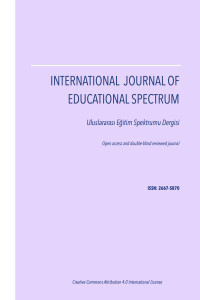Türkçe’de hece başında ünsüz kümelenmesinde ses türemesi ve İngiliz dili eğitimine etkisi
Initial consonant cluster epenthesis in Turkish and its implications to EFL
epenthesis consonant clusters, onset, Turkish,
___
- Abrahamsson, N. (1999). Vowel epenthesis of /sC(C)/ onsets in Spanish/Swedish interphonology: A longitudinal case study. Language Learning 49 (3), 473-508.
- Benzer, A. (2010). Türk Hece Yapısındaki Değişmeler. Turkish Studies: International Periodical For The Languages, Literature and History of Turkish or Turkic 5 (1), 830-842.
- Carlisle, R. S. (1998). The acquisition of onsets in a markedness relationship: A longitudinal study. Studies in Second Language Acquisition 20, 245 – 260.
- Delatorre, F. (2006). Brazilian EFL Learners’ Production of Vowel Epenthesis in Words Ending in –ed. (Unpublished Doctoral Dissertation). Universidade Federal de Santa Catarina, Florianópolis, Brazil.
- Dupoux, E., Kakehi, K., Hirose, Y., Pallier, C., & Mehler, J. (1999). Epenthetic vowels in Japanese: A perceptual illusion? Journal of Experimental Psychology: Human Perception and Performance 25 (6), 1568-1578.
- Harrison, K. D. (1999). Tuvan reduplication and harmony. Proceedings of the 25th Annual Meeting of the Berkeley Linguistics Society: Special Session on Caucasian, Dravidian, and Turkic Linguistics (2000), (pp.75–86).
- Hooper, J. B. (1976) An introduction to natural generative phonology. New York: Academic Press.
- Kabak, B. & Idsardi, W. (2003). Syllabically Conditioned Perceptual Epenthesis. Proceedings of the Twenty-Ninth Annual Meeting of the Berkeley Linguistics Society: General Session and Parasession on Phonetic Sources of Phonological Patterns: Synchronic and Diachronic Explanations (2003), (pp. 233-244).
- Kaun, A. (1999). Epenthesis-Driven Harmony in Turkish. Proceedings of the 25th Annual Meeting of the Berkeley Linguistics Society: Special Session on Caucasian, Dravidian, and Turkic Linguistics (2000), (pp.95–106).
- Prince, A. & Smolensky, P. (2004). Optimality Theory: Constraint Interaction in Generative Grammar. MA, USA: Blackwell Publishing.
- Rose, Y. & Demuth, K. (2006). Vowel epenthesis in loanword adaptation: Representational and phonetic considerations. Lingua 116 (2006), 1112-1139.
- Saussure, F. de (2011). Course in General Linguistics (Edited by Charles Bally and Albert Sechehaye, Translated by Wade Baskin). New York: Columbia University Press.
- Ulkersoy, N. (2007). Markedness Differential Hypothesis and The Phonological Errors of Turkish EFL Learners. (Unpublished Doctoral Dissertation). Cukurova University, Adana, Turkey.
- Vaux, B. (2001). Consonant Epenthesis and Hypercorrection. Retrieved from https://pdfs.semanticscholar.org/097a/f212f739cdc3091888f57a9ece94fe447c79.pdf
- Yavas, M. (1979). Vowel harmony, natural phonology and the problems of borrowing. Kansas Working Papers in Linguistics 4 (2), 41-53.
- Zimmer, K. & Orgun, O. (1999). Turkish. In IPA (ed.), Handbook of the International Phonetic Association: A guide to the use of the International Phonetic Alphabet, (pp.154–158). Cambridge: Cambridge University Press.
- ISSN: 2667-5870
- Yayın Aralığı: Aylık
- Yayıncı: Hakan ULUM
Türkçe’de hece başında ünsüz kümelenmesinde ses türemesi ve İngiliz dili eğitimine etkisi
Bilal GENÇ, Namık ÜLKERSOY, Volkan DARMAZ
Avrupa eğitim alanı bağlamında Gürcistan
Okul öncesi eğitimde deprem farkındalığı: Deprem benden küçüksün” projesi, Tokat ili örneği
Nuran TUNCER, Şahin SÖZEN, Şükriye SAKAR
Türkiye ve Çin milli eğitim bakanlıklarının stratejik planlarının karşılaştırılması
